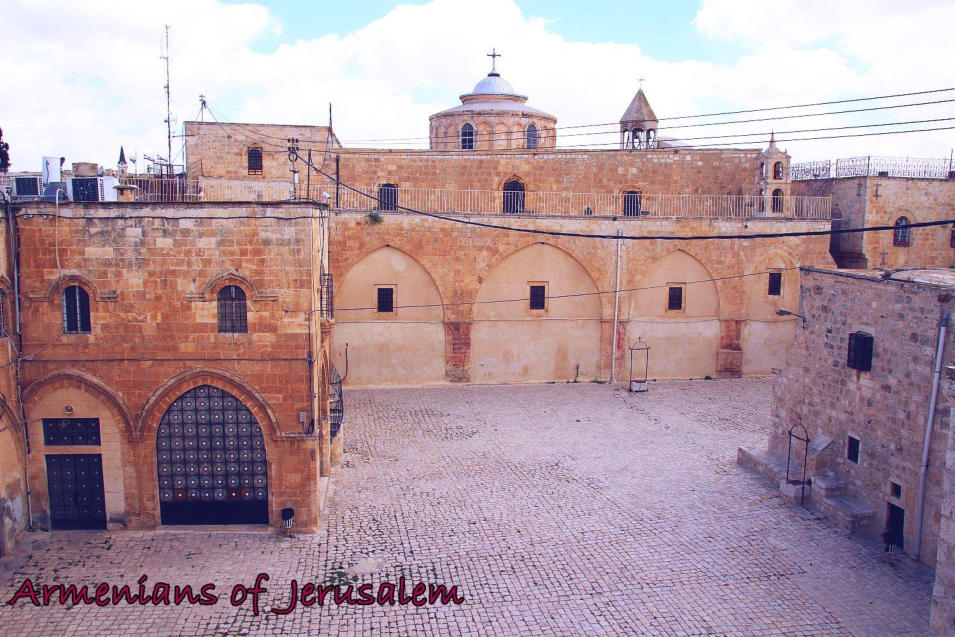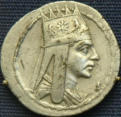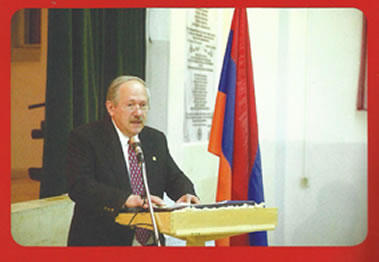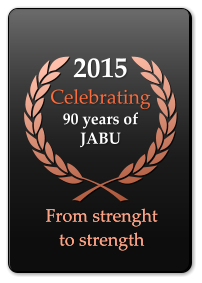

Armenian Jerusalem


“Medz pag”, the St James courtyard


It
was
a
great
honor
to
be
part
of
the
90th
Anniversary
Celebration
of
the
Jerusalem
Armenian
Benevolent
Union.
I
spoke
briefly
about
the
history
of
the
kaghakatsis,
the
Native
Armenian
Community
of
Jerusalem.
There
is
no
Christian
History
of
Jerusalem
without
the
presence
of
Armenians
in
the
Holy
City.
Since
the
year
70
AD
with
the
capture
and
destruction
of
the
Temple
by
Roman
Legions
under
Titus,
the
upper
city
with
Herod's
Palace
was
given
to
the
Armenian
Legionnaires.
And
the
main
street
on
Mt.
Zion
was
called
after
them
"Ruda
Armeniorum".
Which
is
the
Current
Armenian
Orthodox
Patriarchate
Road
and
the
St.
James
Compound
including
the
Armenian
Quarter,
which
covers
an
area
of
300
acres
constituting
1/6th
of
the
area of the Old City.
Before
and
after
the
conversion
of
the
Armenians
to
Christianity
in
301
AD,
many
Armenian
monks
and
pilgrims
came
to
the
Holy
Land
and
established
monasteries
and
shrines
on
the
dominical
sites.
During
the
Arab
conquest
in
636-38
AD
the
Armenians
had
70
churches
through-out
the
Holy
Land
and
a
large
community
in
Jerusalem
with
their
own
Bishop
(Abraham)
who
had
previously
met
with
the
Prophet
Muhammad
in
Mecca
and
received
a
special
protection
and
favors
from
the
Muslims
and
Omar
Ibn
El
Khatab
who
entered
Jerusalem
in
638
AD
and
honored
the
promise
of
the
Prophet
and
granted
the
Armenians
a
Covenant
(Firman)
as
the
protected
people
under
the
Dhimma
and Bishop Abraham became the Armenian Patriarch of Jerusalem separate from the Greek Patriarchate.
The
Armenian
Community
in
Jerusalem
flourished
during
the
Crusader
Kingdom
from
1099-1187.
Three
Armenian
Queens,
the
wives
of
the
Crusader
Kings
in
Jerusalem,
were
pious
benefactors
especially
Queen
Melisende.
She
built
several
churches
including
the
famous
St.
Anne
and
the
main
Market
Place
(Souq
El
Attareen)
and
is
buried
in
Gethsemane within the Church of St. Mary's Tomb.
According
to
historians
during
the
Crusades
there
were
more
than
one
thousand
Armenian
families
living
in
the
Holy
City
and
more
than
500
Armenian
monks
and
priests
constituted
the
St.
James
Brotherhood.
The
civilian
Armenians
were
mostly
high
ranking
military
men,
merchants,
builders
and
artisans.
The
present
day
Jerusalemite
kaghakatsis (Lay Residents) trace their ancestry to those families.
Through
the
past
centuries,
the
Armenians
of
Jerusalem
have
become
the
guardians
of
the
Holy
places
and
protected
the
rights
and
privileges
of
the
Armenian
Church
in
the
Holy
Land.
The
kaghakatsis
had
several
Bishops
who
became
Patriarchs
of
Jerusalem,
to
mention
a
couple
of
them,
Abraham
of
Jerusalem
from
1180-1191,
Garabed
of Jerusalem from 1238-1254. Giragos of Jerusalem from 1846-1850.
The
Armenians
of
Jerusalem
suffered
like
all
the
other
Christian
denominations
during
the
harsh
and
cruel
400
year
rule
of
the
Ottoman
Turks
from
1517-1918.
Bribery
was
rampant
and
the
Sultans
infringed
on
the
rights
and
properties
of
the
weaker
Christian
Denominations.
Under
the
heavy
burden
of
taxation
many
churches
were
confiscated.
With
the
decline
of
the
Ottomans
many
European
countries
such
as
France,
Britain,
Russia,
Austria
and
Germany
exerted
pressure
on
the
Turks
and
each
country
started
to
carve
up
lands
and
build
European
style
compounds
around
the
city.
It
is
worth
mentioning
that
as
the
Armenian
Patriarch
Gregory
the
Chain
Berar
was
touring
the
Armenian
Provinces
and
raising
funds
to
pay
the
debts
and
taxes,
in
1740
a
kaghakatsi
priest,
Hanna
Vartabed,
a
capable
administrator
and
politician,
was
able
to
negotiate
with
the
authorities
and
save
many
properties of the Armenian Church.
Living
in
Jerusalem
during
the
Ottoman
rule
was
not
easy.
Jerusalem
was
neglected
by
the
Turks.
In
1844
the
total
population
of
the
city
was
less
than
six
thousand,
of
which
1500
were
Christians,
400
Armenians
and
the
rest
Jews
and
Muslims.
Disease
was
rampant
due
to
the
lack
of
fresh
water
and
sanitation.
The
city
gates
closed
at
6:00pm.
Those
who
couldn't
get
in
were
left
out
to
the
mercy
of
vagabonds
and
packs
of
vicious
Judean
Hyenas.
Because
of
the
Crimean
war
Christian
pilgrimages
were
cut
short
and
poverty
and
despair
fell
on
the
Jerusalemites.
With
the
rise
of
the
Arab
Revolt
in
1830's
against
the
Turks
by
Muhammad
Ali
of
Egypt
and
the
Western
powers
intervened
in
support
of
the
Sultan
who
obliged
his
Western
friends
by
granting
them
privileges
in
the
Holy
Land.
For
example
in
1859
the
Russian
Emperor
Alexander
the
II
on
18
acres
of
land
outside
the
city
built
the
Russian
compound.
Franz
Joseph of Austria built the Hospice on the Via Dolorosa.
The
French,
the
British,
the
Germans
and
American
missionaries
built
churches,
hospitals
and
colonies
outside
the
walls
of
the
city.
Sir
Moses
Montefiore
in
1860
built
the
windmill
and
the
Jewish
compound
on
the
hill
across
from
the
Jaffa
Gate.
This
construction
boom
was
a
blessing
to
the
members
of
the
Armenian
community.
Many
of
the
kaghakatsis
were
master
craftsmen,
carpenters,
masons,
blacksmiths,
who
earned
good
money
over
the
years
and
saved enough to build homes in the new suburbs and move out of the Old City.
At
the
turn
of
the
20th
century
the
Armenian
community
was
one
of
the
most
dynamic
and
progressive
communities
in
Jerusalem.
Kaghakatsis
held
prominent
positions
in
government,
banking,
trade
and
other
professions. Here are some examples just to mention a few.
Governor's Office:
Boghos
Efendi
Zakarian
(Deputy
to
Mutassarrif),
Sahag
Efendi
Nerssessian
(Chief
of
police)
&
Hovaness
Khachadourian
(Chief Tax collector).
Consular Officers:
Hagop
Pascal
(Vice-consul
for
Austria
&
Hungary),
Haroutune
Torossian
(Vice-consul
for
Prussia),
Hagop
Serabyon
Mouradian (Consular Agent for the USA) & Simon Frederick Mouradian (Vice-consul for Germany).
Banking:
Levon
Kevorkian,
Khachadour
Krakerian
(Ottoman
Bank
Managers),
Hagop
Kevorkian,
Apraham
Moukhtarian,
Hovsep
Simonian (Banca di Roma), Vahe Zakarian, Hagopos Mergerian & Khachadour Gazmararian (Barclays).
Merchants:
Megurdich Kaplanian, Garabed Zakarian, Kevork Mergerian, Boghos Mergerian & Hovaness Garabed Gazmararian.
Money Changer:
Kevork Torossian, Giragos Giragossian & Anton Minassian.
Physicians:
Vahan Kalbian, Vahan Pascal Mouradian Armenag Khachadourian & Krikor Krikorian (Laboratoire).
Pharmacist:
Kevork Kaplanian, Hagop Kevorkian & Sarkis Badgerahanian.
Photographers:
Garabed Kevorkian, Hovaness Krikorian, Yeghia Hagopian, Hovaness Benneian & Sahag Sahagian.
Postal Clerks:
Artin Torossian (Post Master), Tavit krikorian, Michael Zakarian & Hovhaness Moukhtarian.
Artists/Painters:
Aram Khachadourian, Hagop Moukhtarian, Hagop Badgerahanian & Khachadour Koukeian (Olive wood carver).
Tourist Agencies:
Hagop Sarkissian (Cook Travels) & George Garabedian.
Carpenters:
Kevork
Aghabegian,
Hovaness
Aghajanian,
Hagop
Dickranian,
Apkar
Hovsepian,
Stepan
Negoghossian,
Hagop
yeghyaian & Megurdich Minassian.
Shoemakers:
Boghos Kaplanian, Hagop Krikorian, Tateos Tateossian, Kevork Kaplanian, Hovsep Garabedian & Krikor Mnatzaganian.
Tailors:
Kapriel
Aghajanian,
Kevork
Terzibashian,
Hagop
and
Apraham
Terzibashian,
Mrs.
Yeghnig
Kankashian,
Miss
Serpouhi
Mnatzaganian, Haroutune Babigian & Mrs. Zarouhi Elmezian.
Watchmakers:
Sarkis Baghdigian Sarkissian & Kevork Sarkissian.
Barbers:
Minas
Andonian,
Sarkis
Kaplanian,
Hovsep
Kaplanian
(Mazloum),
Artin
Koukeian,
Zakar
Zakarian,
Boghos
Jinivizian,
Khachadour Manougian, Soukias Chilingirian, Apraham Sdepanian, Haroutune Benneian & Vart Aghajanian.
Blacksmiths:
Apraham
Aprahamian
(Razouk),
Hagop
Aghabegian,
Nigohos
Kevorkian,
Hovaness
Nazigian,
Nazaret
Benneian,
Hagop
& Apraham Bedevian.
Note:
Certain
identical
names
represent
successive
generations
in
the
same
or
different
professions.
(Regretfully
many
more
names
are
left
out)
a
full
list
is
posted
on
the
Armenians
of
Jerusalem
website
[http://armenian-
jerusalem.org].
Conclusion:
In
spite
of
the
ongoing
political
crisis
and
turmoil
in
the
Holy
Land,
the
centuries
old
Armenian
community
continues
to
hold
on
to
its
traditions
and
contributions
to
the
preservation
of
the
Armenian
Christian
Heritage in Jerusalem under the patronage of the Patriarchate of St. James.
David Terzibashian
(April 29, 2015)
Photo Courtesy
























